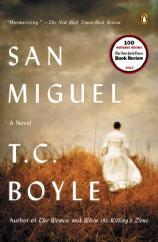San Miguel
Review
San Miguel
A novel’s setting can be as important as any of the characters who populate the story. The island on which the action in SAN MIGUEL, T.C. Boyle’s latest, takes place --- with its smells of sea wrack and salt spray and the “pocked volcanic cliffs fringed with a poor sort of desert vegetation” --- is integral to the sagas of the two families that live there over the book’s 54 years. And Boyle’s loving depiction of this now-uninhabited island is among the novel’s greatest pleasures.
Based on real events, SAN MIGUEL is comprised of two independent short novels. The first, set from 1888 to 1890, is the tale of the Waters family. Marantha Waters suffers from consumption. Her husband, Will, suggests that they move to San Miguel from their comfortable home in Santa Barbara. The reason he gives is that the climate will improve Marantha’s health. But his real motivation is that he has always dreamed of running a sheep farm. When the opportunity to do so presents itself on San Miguel, Will convinces his wife to give him her last $10,000 so that they can begin a new life on the island.
"The first 200 pages of SAN MIGUEL are wonderful. Boyle’s depiction of the Waters clan is as compelling as anything he’s ever written. His prose is, as always, economical and precise."
Marantha, Will, and Marantha’s adopted 14-year-old daughter, Edith, take a schooner to the island on New Year’s Day, 1888. From the outset, it’s clear that life will be difficult. The episodic narrative chronicles Edith’s adoption of a lamb she finds bleating in the middle of the night, Marantha’s adjustment to a leaking bedroom ceiling and farm hands who crack sexist jokes during meals, and Will’s changing personality. As Marantha’s health worsens, Will’s frustrations manifest themselves in ways that are almost as devastating as his wife’s illness.
The tension mounts beautifully through the first 200 pages, but then Boyle switches gears. Suddenly it’s 1930, and Elise Lester, a former librarian who had never been west of New York before her marriage, is sailing from southern California with her husband Herbie, a World War I veteran still suffering from the effects of shell shock. Unlike Marantha Waters, Elise is enthusiastic about their becoming the farm’s new overseers. She and Herbie view their adventure as a way to escape the real world. Herbie is the kind of sensitive soul who is excited about raising the three baby mice he finds on the island. He is also proud of the gun collection he continues to amass, an assortment that includes an elephant gun he’d love to take on safari.
Real life is hard to escape, however. When the press hears about their life on the island and the two daughters Elise is homeschooling --- Life magazine dubs the clan Swiss Family Lester --- the family receives more attention than Elise would like. And it’s not long before the attack on Pearl Harbor forever alters the Lesters’ life in the Pacific.
The first 200 pages of SAN MIGUEL are wonderful. Boyle’s depiction of the Waters clan is as compelling as anything he’s ever written. His prose is, as always, economical and precise. If the whole novel had been about the Waterses, this would have been one of Boyle’s better efforts. But the abrupt shift to the Lesters doesn’t work. A transition from one cast of characters to another sets up an expectation in the reader. You anticipate that one story will comment on the other, that the result will be something greater than two separate tales about two different clans. But except for the setting and a brief update on the Waterses from a hired hand who worked for both families, the second half of the book has nothing to do with the first. Even this would have been fine if the second story had been compelling. But the Lesters aren’t as well drawn as their predecessors, and an astute reader will figure out the ending well before the final page.
The impression one gets from SAN MIGUEL is that there wasn’t much more to tell about the Waterses after 1890, so Boyle switched to the other family to fill out the book. The result is no doubt a faithful if fictionalized account of actual events, but the absence of connective tissue weakens the book’s power. T.C. Boyle has written some of the best American novels of the past 30 years. It’s a pity that the second half of this book isn’t as elegant as the first.
Reviewed by Michael Magras on September 20, 2012
San Miguel
- Publication Date: September 24, 2013
- Genres: Fiction, Historical Fiction
- Paperback: 384 pages
- Publisher: Penguin Books
- ISBN-10: 0147509750
- ISBN-13: 9780147509758





